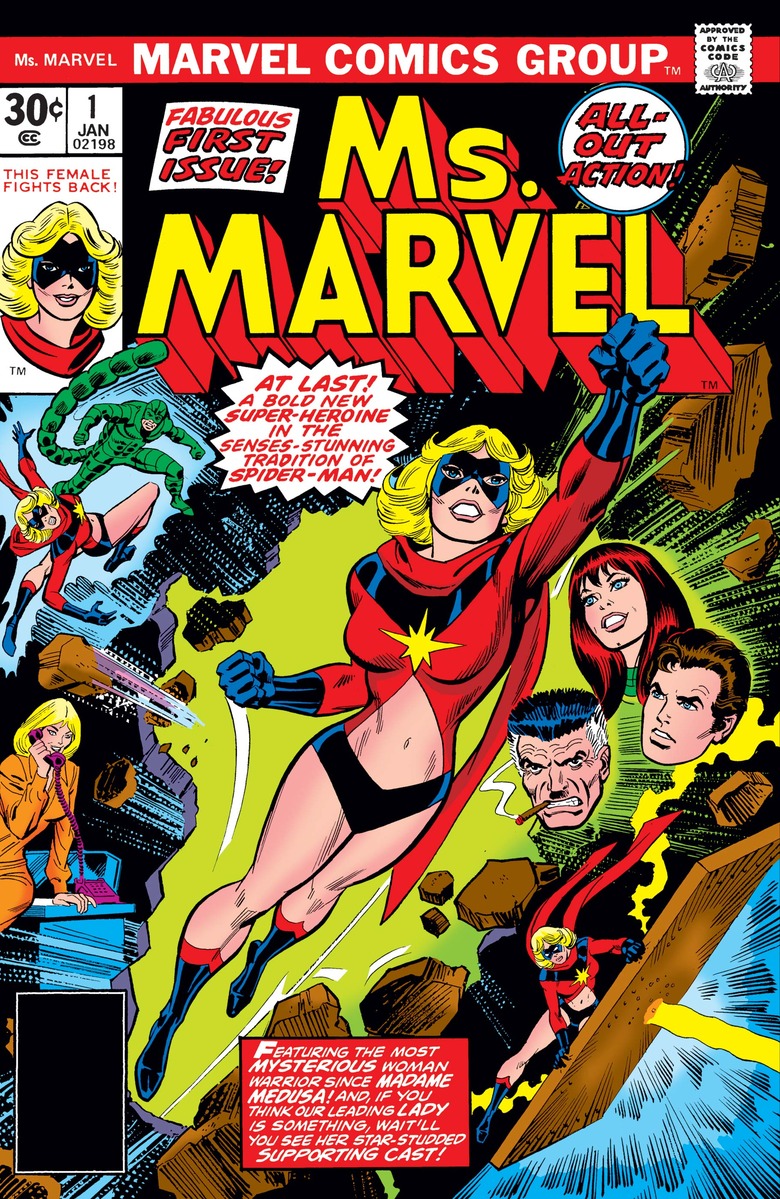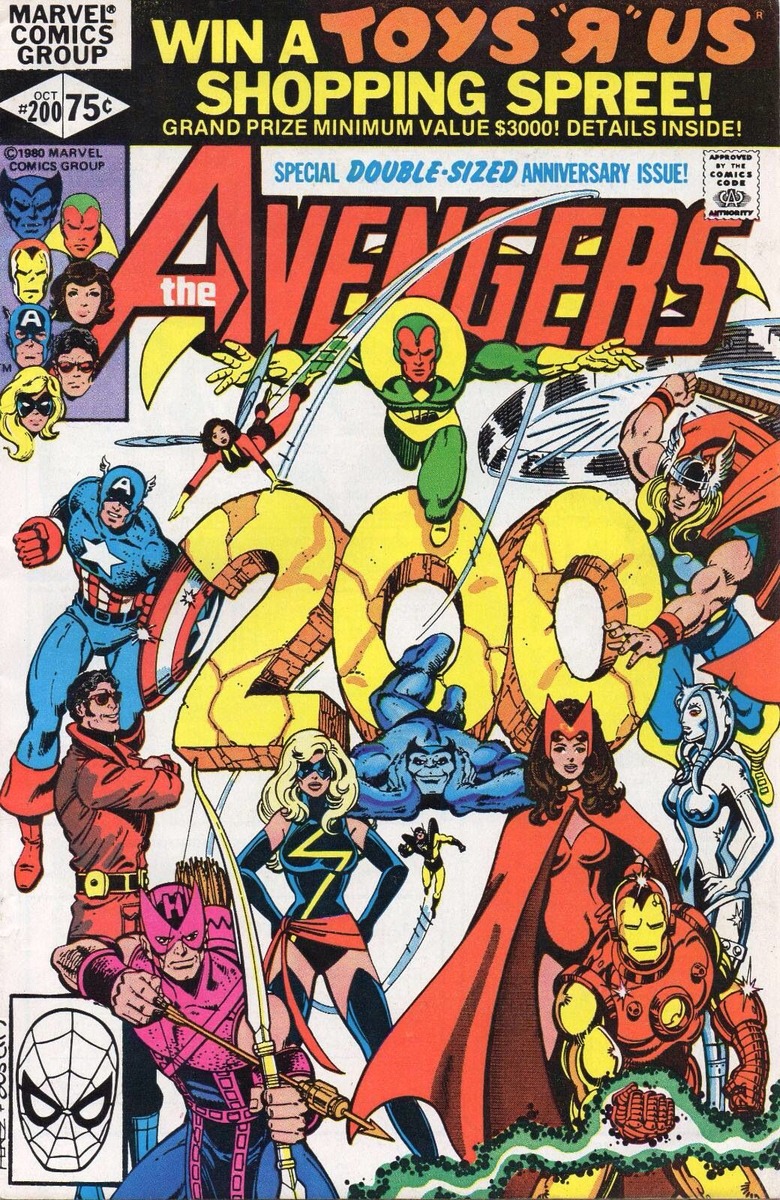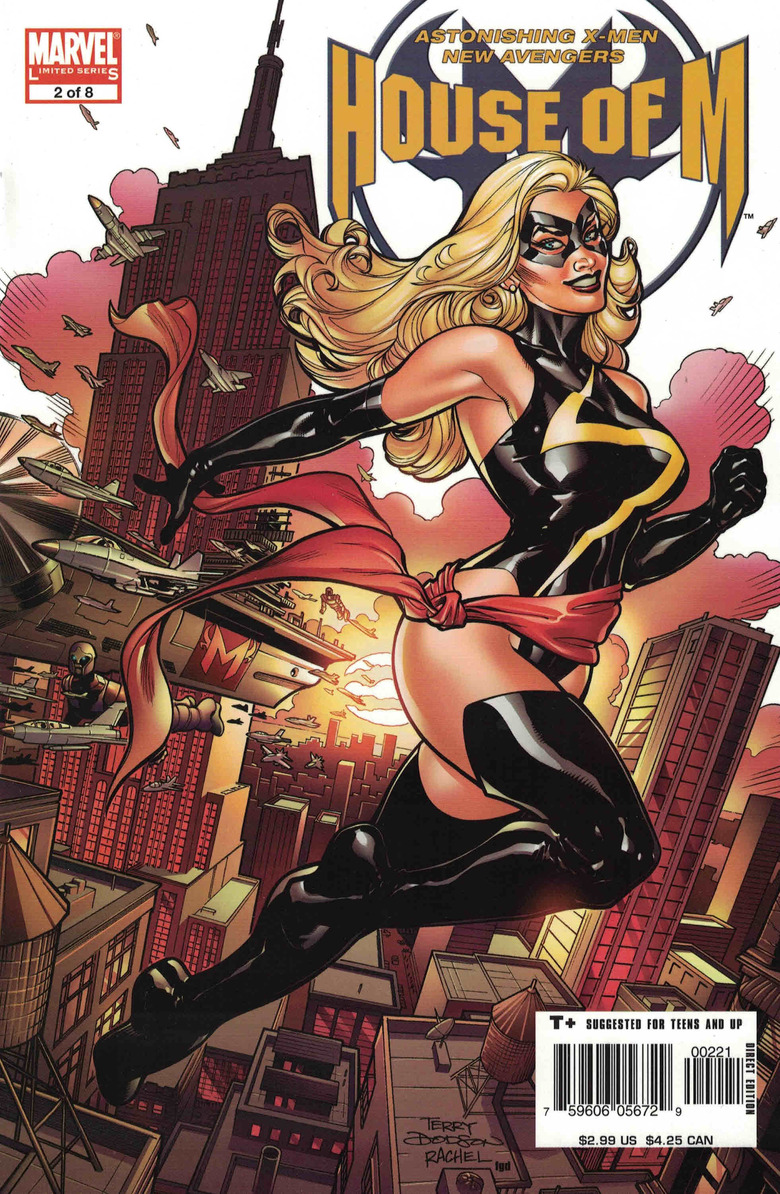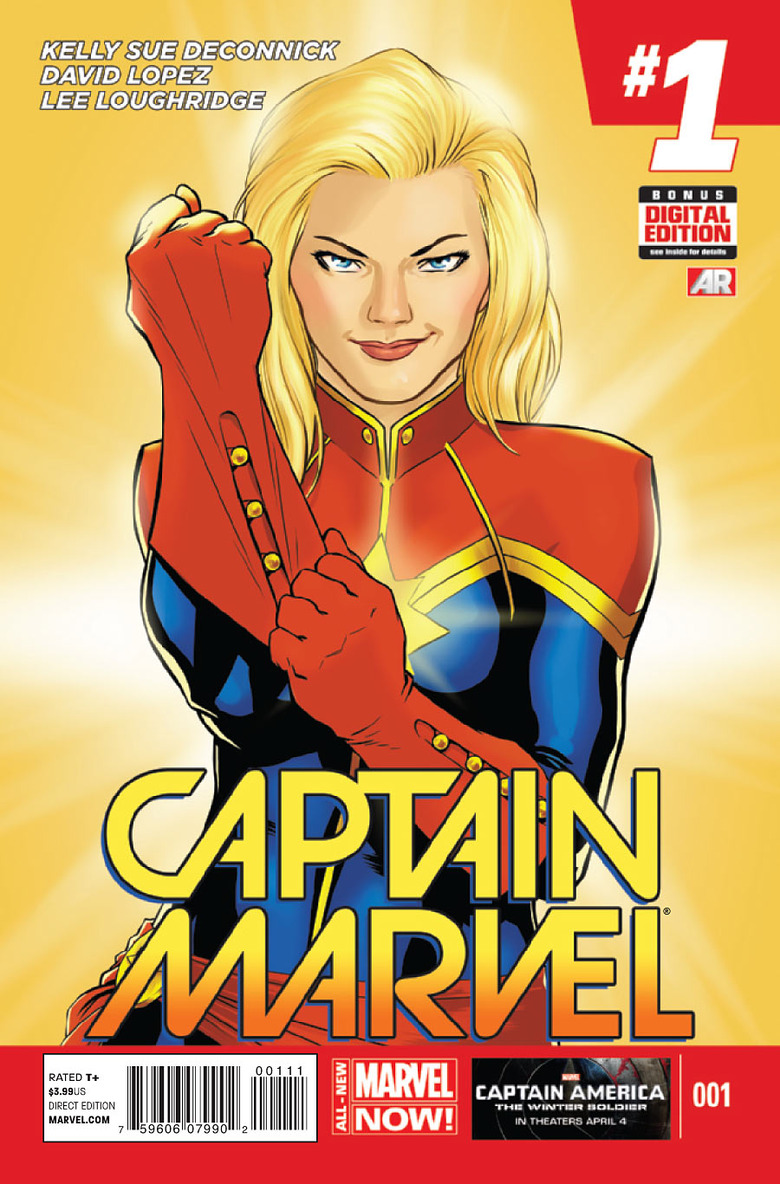'Captain Marvel' And The Bizarre Comic Book History Of Carol Danvers
Most big-screen superheroes tend to take a form resembling their original comics. Batman has always been a caped crusader, Superman has always leapt tall buildings in a single bound, and Spider-Man has always been a dorky webslinger. Even Marvel Studios has delivered comic-accurate versions of characters like Captain America and Iron Man, whose movie origins can be traced back to their comic book debuts. Captain Marvel however, has a long, complicated and at times bizarre history.Carol Danvers isn't the first Marvel character to use the title (she isn't even the first woman), and for the first decade of her existence, she wasn't even a superhero. Now, she's a Marvel Comics A-Lister, ready to be launched into the stratosphere in Captain Marvel, where she'll be played by Brie Larson (Room, Short Term 12).The Anna Boden & Ryan Fleck-directed film skips over a lot of Carol's history — some of it for good reason — and, without giving too much away, remixes certain elements. Carol's long, winding road to the big-screen is the product of dozens of creative voices, leading to a history that's everything from fascinating to appalling.Now that she's finally ready for her mainstream arrival, let's take a look at how she got here.
The Early Years
Long before Marvel existed, the folks at Fawcett Comics created the first Captain Marvel, known today as Shazam, back in 1939. The character, a kid named Billy Batson who could transform into an adult superhero, makes his own big-screen debut in DC's Shazam! this April (we'll get into his history soon). He hasn't gone by the name "Captain Marvel" since 2011; in fact, his title was rebranded Shazam! when he was brought into the DC fold in in 1972, by which point Marvel Comics had their own version of the character.After Fawcett ceased publishing Captain Marvel in 1953 (owing to a lawsuit from DC, alleging similarities to Superman), Marvel Comics took advantage of the eventual lapse in ownership and trademarked the name. In 1967, Stan Lee and Gene Colan debuted Marvel's first Captain Marvel, the Kree warrior Mar-Vell, in Marvel Superheroes #12. The following issue, Marvel Superheroes #13, saw the first appearance of U.S. Air Force officer Carol Danvers, who later became romantically involved with Mar-Vell's human alias, Walter Lawson,In both his first appearance and his solo debut (Captain Marvel #1, 1968), Mar-Vell had a white and green colour scheme, and a design reminiscent of a Green Lantern. Gene Colan, while Mar-Vell's illustrator for over a year, infamously hated the design — writer Roy Thomas and Penciler Gil Kane eventually gave the character his signature red and black in 1969's Captain Marvel #17.In the following issue, Captain Marvel #18, Carol is injured in an explosion caused by the villainous Kree commander Yon-Rogg; she survives, and even gains powers from the event when her DNA was fused with Mar-Vell's, though she wasn't promoted to superhero status — flight, strength and precognition — until Ms. Marvel #1 (Gerry Conway, John Buscema) in 1977, a few years after Mar-Vell's solo book was cancelled. She also adopted his red & black scheme, with a glowing golden emblem at the center.Carol's first solo book was focused on feminist issues of the era. Her very first story saw her fight for equal pay for women, and she even took an editorial job at the Daily Bugle's Women's Magazine, which J. Jonah Jameson sought to fill with fluff pieces. The "Ms." honorific (pronounced "miz" in some countries, "miss" in others) was even chosen to align her with the ongoing conversations about how women were primarily addressed in the context of marriage ("Mrs." for married woman, "Miss" for unmarried) rather than as individuals; "Ms." could be used regardless of marital status.While heavy-handed, Conway's PSA-laden writing kept Ms. Marvel afloat for two issues, after which writer Chris Claremont took over and sent Carol on more fantastical adventures. During Claremont's run, Carol upgraded to the outfit she would be associated with for the next three decades (the black leotard, golden lightning strike and red sash) in Ms. Marvel #20. During this series, and shortly after, she crossed over into titles led by the other Avengers, which meant she she'd continue showing up even in Marvel comics after her solo series was cancelled in 1979.A blessing, it would seem, but that's when things got weird — to put it mildly. This next section requires a trigger warning for sexual assault.
The ’80s
In the anniversary issue Avengers #200, Marvel's then editor-in-chief James Shooter, along with writer and artist George Pérez, took the reins on a story that went far, far against the Ms. Marvel creative ethos up until that point. After Carol finds herself suddenly pregnant — she's several months along and has no explanation — it's revealed that the time-traveling alien villain Marcus Immortus mind-controlled her, forcefully impregnated her, and wiped her memory. To make matters worse (and more convoluted), the rapidly-aging baby she carried against her will was the future Marcus himself, who concocted this ploy so he could be born into an Earth-compatible body.Carol initially tells the Avengers how used she feels, as is the ostensibly correct approach in stories such as this, but she eventually comes around to Marcus' twisted idea of romance — the rapidly aged-up, time-displaced Marcus she gave birth to, mind you. The other Avengers, including Iron Man, even support her decision to ride off into the sunset with the man who raped her. The narrative never seems to think twice about this decision, and Carol wouldn't be seen in Marvel comics for the following year. That is, until Chris Claremont got his hands back on the character and scathingly un-wrote the storyline.In Claremont's Avengers Annual #10 (art by Michael Golden), the X-Men find Carol Danvers de-powered (by a debuting Rogue, then a villain), after which it's retroactively revealed that when she left with Marcus Immortus, she was still being mind-controlled, She held this against the Avengers — and by proxy, Marvel's all-male editorial team — for going along with Marcus' ploy.Claremont would then bring Carol into the Uncanny X-Men fold, where she was first the X-Men's de-powered human ally and then, thanks to experimentation by aliens The Brood, she was turned into the mega-powered Binary, whose star-like abilities she seems to reflect in the upcoming movie, whenever she goes all Super Saiyan.After brief rendezvous with teams like Excalibur and the New Mutants, Carol rejoined the Avengers in the '90s under the name Warbird (the Ms. Marvel moniker had most recently been used by Sharon Ventura, later known as She-Thing). After losing her memories and cosmic powers, she deals with alcoholism for a brief period, but the character's popularity waned in an era all about guns, muscles, and juvenile hyper-violence.However, Carol rose to prominence once again in a landmark story that shook the Marvel universe to its core.
The 2000s
In the story House of M, Scarlet Witch (Wanda Maximoff) creates and alternate reality where mutants, led by her father Magneto, rule the Earth. In this reality, Carol Danvers is one of the world's most popular and beloved superheroes; a celebrity of sorts. After the world is returned to its original state (short a few million mutants; a story for another time), Carol retains her memories from this alternate timeline, after which her second solo series was launched under writer Brian Reed.Reusing the Ms. Marvel name, Carol's subsequent adventures were rooted in balancing her personal life, including budding friendships with reformed H.Y.D.R.A. agent Spider-Woman (Jessica Drew) and actor-superhero Wonder Man (Simon Williams), among others. The series, which ran from 2006 until 2010, fleshed out the modern version of Carol Danvers, a woman on the precipice of celebrity having to contend with both every day realities and superhero adventures. (She even had a hand in the comic storyline Civil War.)Shortly after, she dies and is resurrected (hey, it's comics), she battles her replacement Ms. Marvel (the Dark Avengers' Kara Sofen/Moonstone) and her own Skrull impostor, rounding off a rather eventful decade with battles a-plenty alongside the Avengers. By this point however, Mar-Vell had been dead for nearly 30 years, and it seemed time to cement Carol as the A-lister she deserved to be.
The 2010s
Before Carol rose through the ranks, the Captain Marvel title had been held by Mar-Vell, African American policewoman Monica Rambeau — later known as Photon, Pulsar and, last I checked, Spectrum — Mar-Vell's son Genys-Vell and his daughter Phyla-Vell, the Skrull Kh'nr (who impersonated Mar-Vell), and the Kree Diplomat Noh-Varr, a.k.a. Marvel Boy. You don't need to know any of this going into the Captain Marvel movie, other than the fact that Monica Rambeau appears as a child.Carol was relaunched as Captain Marvel in 2012 by writer Kelly Sue DeConnick and artist Dexter Soy. Her new outfit, designed by Jamie McKelvie, combined Mar-Vell's colour scheme, Carol's Air Force uniform, and a sash reminiscent of her days as Ms. Marvel; an aspect to the character that become important this century was the ways in which she paid tribute.Now an A-list Avenger, she even inspired young Pakistani-American teen Kamala Khan to take up her ooldmantle of Ms. Marvel, though Carol, while a heroic figure, still retains her core of trying to balance being a public figure with her topsy-turvy personal life, including a romance with James Rhodes (War Machine) and her continued best-friendship with Jessica Drew, whose infant son she helps take care of.After losing her memory (again), joining the Guardians of the Galaxy, and protecting several corners of the cosmos in a various permutations — she even led S.W.O.R.D. at one point (yes, there's a S.W.O.R.D.) — Carol's origin was re-written in 2018's The Life of Captain Marvel in order to align her with the upcoming film. I won't spill the details here, in case you'd like to watch the movie knowing as little as possible, but rest assured, most fans will be pleased by how the movie collapses and re-contextualizes Carol's convoluted history.So, what's next for Carol Danvers? After Captain Marvel this week, she's set to appear in next month's Avengers: Endgame, a film that will both conclude the Marvel Cinematic Universe up until this point, and likely lay the foundation for what comes next. Given her film's estimated $100-$150 million domestic opening, it feels all but certain that Carol will take her rightful place in the mainstream alongside the likes of Iron Man and Captain America, the way she has in the comics over the last fifteen years.




